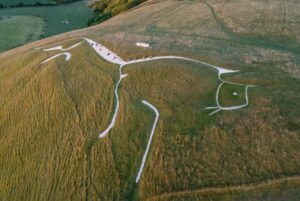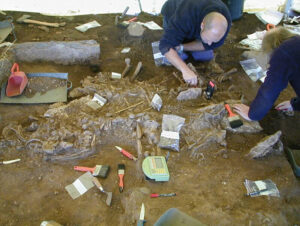Archaeologists found the oldest-ever recorded runestone at a burial site in eastern Norway — and it could bear the name of the woman buried in the nearest grave.
Researchers with the University of Oslo’s Museum of Cultural History first investigated the grave field in the Hole municipality in fall 2021. After the team turned up the stone and grave in question, they used radiocarbon dating to determine the age of the artifacts.
That’s when they found that both finds date to around 1-250 AD — making the inscription about 2,000 years old.
The oldest runestone in the world will soon be exhibited at the Historical museum in Oslo.
The stone was found in a grave in Ringerike in Norway which is between 1,800 and 2,000 years old.
The exhibition will last from 21st January until 26th February. pic.twitter.com/FIi6o6dmS6— Grimfrost (@TheGrimfrost) January 20, 2023
Researchers named the stone after the site: Svingerudsteinen (the Svingerud Stone).
‘Idiberug’
It’s the oldest carved-stone fragment of the ancient Germanic writing ever discovered. While researchers have found older examples of runic writing, such as one inscription carved into a bone comb in Denmark, the recent find marks the oldest runestone.
Inspired by classical, widely dispersing forms of writing like the Roman alphabet, ancient Scandinavians created their own characters, called runes. The stones helped them acquire knowledge about new customs and forms of organization during this period, known as the Roman Iron Age.
The flat, square sandstone tablet measures about 31 by 32cm. The museum determined that whoever carved the eight-character inscription spoke a language that acted as “the ancestor language of modern Nordic languages.”
Translated into the Roman alphabet, the clearly demarcated characters on the stone spell “idiberug.”
What’s that?
“The text may refer to a woman called Idibera and the inscription could mean ‘For Idibera,’” said runologist Kristel Zilmer, Professor of Written Culture and Iconography at the museum. “Other possibilities are that Idiberug is the rendering of a name such as Idibergu, or perhaps the kin name Idiberung…And there are other possible interpretations — as common with early runic inscriptions.”
The stone’s runic and other markings don’t end there. It also bears the first three characters of the runic alphabet — ᚠ (f), ᚢ (u), and ᚦ (th) — in one place. And it shows multiple patterned carvings.
Carved by a language learner?
The jury’s still out on what it all means, but Zilmer has developed theories over the course of her inquiry, now entering its second year.
“The stone has several kinds of inscriptions,” she said. “Some lines form a grid pattern and there are small zigzag figures and other interesting features. Not all inscriptions have a linguistic meaning. It’s possible that someone has imitated, explored, or played with the writing. Maybe someone was learning how to carve runes.”

Other miscellaneous inscriptions on the Svingerud Stone. Photo: University of Oslo Museum of Cultural History
Only about 30 total runestones found in Norway date to as early as 550 AD, let alone as early as the advent of the Common Era. Zilmer describes it as a one-of-a-kind discovery.
“Having such a runic find fall into our lap is…the dream of all runologists,” she said.






